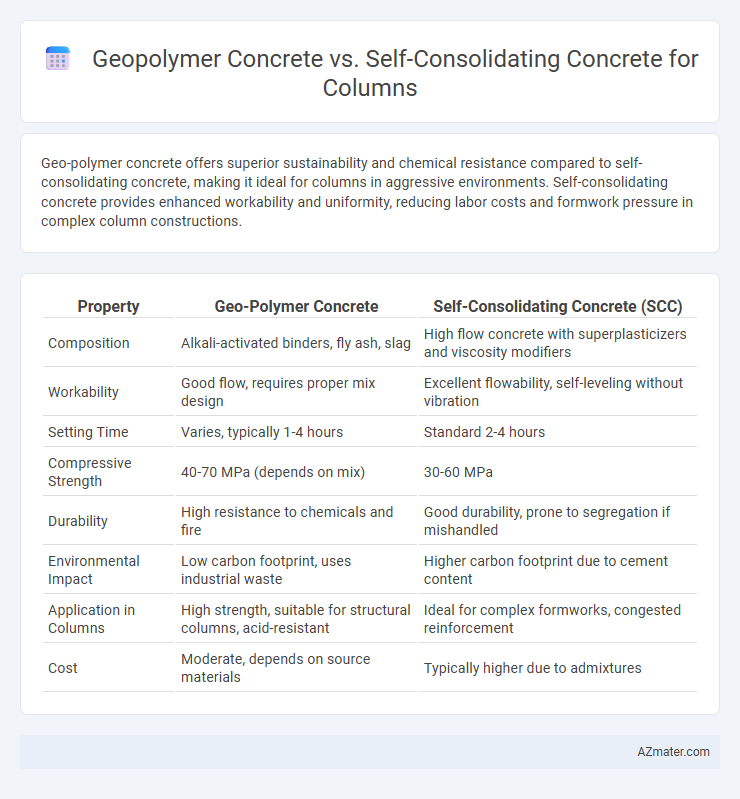Geo-polymer concrete offers superior sustainability and chemical resistance compared to self-consolidating concrete, making it ideal for columns in aggressive environments. Self-consolidating concrete provides enhanced workability and uniformity, reducing labor costs and formwork pressure in complex column constructions.
Table of Comparison
| Property | Geo-Polymer Concrete | Self-Consolidating Concrete (SCC) |
|---|---|---|
| Composition | Alkali-activated binders, fly ash, slag | High flow concrete with superplasticizers and viscosity modifiers |
| Workability | Good flow, requires proper mix design | Excellent flowability, self-leveling without vibration |
| Setting Time | Varies, typically 1-4 hours | Standard 2-4 hours |
| Compressive Strength | 40-70 MPa (depends on mix) | 30-60 MPa |
| Durability | High resistance to chemicals and fire | Good durability, prone to segregation if mishandled |
| Environmental Impact | Low carbon footprint, uses industrial waste | Higher carbon footprint due to cement content |
| Application in Columns | High strength, suitable for structural columns, acid-resistant | Ideal for complex formworks, congested reinforcement |
| Cost | Moderate, depends on source materials | Typically higher due to admixtures |
Introduction to Geopolymer Concrete and Self-Consolidating Concrete
Geopolymer concrete utilizes industrial by-products like fly ash or slag activated by alkaline solutions, offering superior chemical resistance and reduced carbon footprint compared to conventional concrete. Self-consolidating concrete (SCC) is designed for high flowability without segregation, allowing for easy placement in intricate column molds without vibration. Both materials improve column performance, with geopolymer concrete emphasizing sustainability and durability, while SCC focuses on workability and labor efficiency.
Material Composition: Geopolymer vs. Self-Consolidating Concrete
Geopolymer concrete for columns utilizes industrial byproducts like fly ash or slag combined with alkaline activators, resulting in a binder with high chemical resistance and reduced carbon footprint. Self-consolidating concrete incorporates traditional Portland cement with superplasticizers and viscosity modifiers to achieve high fluidity and self-leveling properties without segregation. The distinct material composition of geopolymer concrete enhances durability through inorganic polymer networks, whereas self-consolidating concrete emphasizes workability and placement efficiency in structural columns.
Workability and Placement in Column Construction
Geo-polymer concrete offers superior chemical resistance and environmental benefits but often requires precise mix design adjustments to enhance workability for column placement. Self-consolidating concrete (SCC) excels in high flowability and self-leveling properties, enabling easy placement without vibration, which reduces labor and ensures uniformity in column construction. SCC's rheological properties facilitate rapid, defect-free filling of complex column forms, whereas geo-polymer concretes may demand additional admixtures to achieve comparable flow and consolidation.
Strength Characteristics: Compressive, Tensile, and Flexural
Geo-polymer concrete exhibits higher compressive strength compared to self-consolidating concrete, often surpassing 50 MPa due to its dense aluminosilicate binder structure. Self-consolidating concrete offers superior tensile strength and flexural performance thanks to its enhanced flowability and optimized aggregate distribution, reducing voids and microcracks in columns. Both materials provide distinct mechanical advantages, with geo-polymer concrete excelling in durability and chemical resistance, while self-consolidating concrete improves crack resistance and structural integrity under flexural loads.
Durability and Long-Term Performance in Columns
Geo-polymer concrete exhibits superior durability and long-term performance in columns due to its enhanced resistance to chemical attacks, high-temperature stability, and reduced permeability compared to traditional concretes. Self-consolidating concrete improves structural integrity by ensuring complete consolidation without mechanical vibration, minimizing voids and honeycombing, which enhances the durability of columns under load. However, geo-polymer concrete's low shrinkage and superior alkali resistance make it more suitable for environments prone to aggressive chemical exposure, ensuring extended service life in critical column applications.
Sustainability and Environmental Impact Comparison
Geo-polymer concrete significantly reduces carbon emissions by utilizing industrial byproducts like fly ash and slag, making it a sustainable alternative to traditional Portland cement-based self-consolidating concrete (SCC). SCC, while offering superior flowability and reduced labor costs for column construction, relies heavily on cement production, which is energy-intensive and a major source of CO2 emissions. The lower embodied carbon footprint and enhanced durability of geo-polymer concrete make it a more environmentally friendly choice for sustainable column applications.
Curing Requirements and Setting Times
Geo-polymer concrete for columns exhibits extended curing times often requiring heat curing at 60-90degC for 24-48 hours to achieve optimal strength, while self-consolidating concrete (SCC) typically sets within 2-4 hours at ambient temperature due to its high cement content and admixtures. The curing requirements for geo-polymer concrete involve maintaining elevated temperatures and controlled humidity to facilitate the polymerization process, contrasting with SCC's conventional hydration-based curing that benefits from standard moist curing practices. These differences significantly impact construction scheduling, with geo-polymer concrete demanding longer curing periods but offering enhanced chemical resistance, whereas SCC allows faster formwork removal and early load application.
Cost Analysis for Column Application
Geo-polymer concrete offers significant cost savings for column applications by utilizing industrial by-products such as fly ash and slag, reducing reliance on expensive Portland cement. Self-consolidating concrete (SCC) incurs higher costs due to specialized admixtures and viscosity modifiers required for its flowability and self-compacting properties. Life-cycle cost analysis reveals geo-polymer concrete reduces maintenance and durability expenses, enhancing long-term economic efficiency in structural columns.
Challenges and Limitations in Column Use
Geo-polymer concrete faces challenges in column applications due to its variable setting times and sensitivity to curing conditions, which can lead to inconsistent strength development and bonding issues with steel reinforcement. Self-consolidating concrete (SCC) encounters limitations such as higher risk of segregation and bleeding during placement, potentially compromising the structural integrity and uniformity of columns. Both materials require careful mix design optimization and stringent quality control to address these challenges and ensure durable column performance.
Future Trends and Recommendations for Column Projects
Geo-polymer concrete offers significant sustainability advantages for columns by reducing carbon footprint and enhancing chemical resistance, positioning it as a future-forward material for eco-conscious construction. Self-consolidating concrete provides exceptional workability and uniformity, improving structural integrity and reducing labor costs in column casting applications. Future trends suggest integrating nano-additives with geo-polymer mixes and advancing admixture technology for self-consolidating concrete to optimize durability and performance in complex column designs.

Infographic: Geo-polymer concrete vs Self-consolidating concrete for Column
 azmater.com
azmater.com